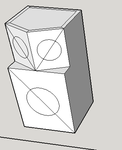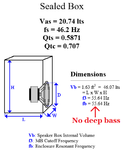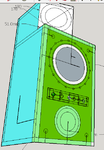Johanx2
Advanced Member level 4

Guys, I am moving soon, and wont complicate too much with the enclosure for now, so I think that the dedicated bass chamber of my enclosure, it's going to be sealed, 1 cubit feet for 8" driver, and filled it with one pound of poly-fill. Have you heard the miracles can do with sealed enclosures? will put 1 pound, which it is the recommended quantity I have read.
Few pages back, I showed the picture design of the enclosure, some did not like it, even me, well, I actually like if compared to having two loud speakers very close each one together, specially if they don't show a form of angle, which I believe it does not help too much for a stereophonic sound effect. Is I mentioned before, my enclosure form its a vertical rectangule, I will go with that form for the saving space feature, (it won't take too much of your floor, but that wont mean that this thing will not sound amazing, it will!
So what I did with the upper chamber (for mids and highs, bass chamber is isolated), what I did, was to... well see the picture below...
So now everything is at the front, and just for now, I think I am very happy with it, not sure if because I am the designer... but I believe its a good idea for the vertical factor with stereo sound, don't you think? I will need to play with angles, not a problem for my circular saw, I have not table saw, but I did a 48x48 platform using some 2x8 lumber, very heavy thing, so I put on the board, and clamp a big aluminum ruler to guide the circular saw, just as accurate you want.
God! that little chinese device slams that subwoofer on 4 ohms, surely it can handle an even more powerful subwoofer and linked on 2ohms, which is when it really kick with power.
The picture shown below, it's not showing the bass ring, the leds, and few more things I am still not done with them, that will be another nice thing I liked, thanks to Bet! and everybody.
Few pages back, I showed the picture design of the enclosure, some did not like it, even me, well, I actually like if compared to having two loud speakers very close each one together, specially if they don't show a form of angle, which I believe it does not help too much for a stereophonic sound effect. Is I mentioned before, my enclosure form its a vertical rectangule, I will go with that form for the saving space feature, (it won't take too much of your floor, but that wont mean that this thing will not sound amazing, it will!
So what I did with the upper chamber (for mids and highs, bass chamber is isolated), what I did, was to... well see the picture below...
So now everything is at the front, and just for now, I think I am very happy with it, not sure if because I am the designer... but I believe its a good idea for the vertical factor with stereo sound, don't you think? I will need to play with angles, not a problem for my circular saw, I have not table saw, but I did a 48x48 platform using some 2x8 lumber, very heavy thing, so I put on the board, and clamp a big aluminum ruler to guide the circular saw, just as accurate you want.
God! that little chinese device slams that subwoofer on 4 ohms, surely it can handle an even more powerful subwoofer and linked on 2ohms, which is when it really kick with power.
The picture shown below, it's not showing the bass ring, the leds, and few more things I am still not done with them, that will be another nice thing I liked, thanks to Bet! and everybody.







